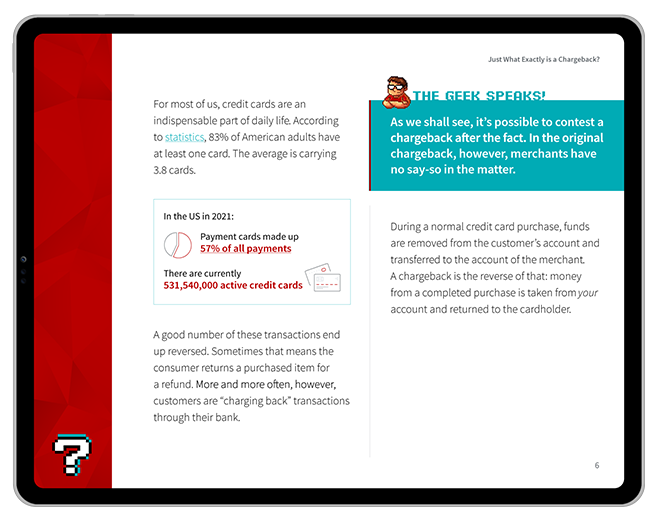How Do You Calculate Your eCommerce Return Rate? What Can You Do to Keep Your Numbers Low?
eCommerce merchants rely on accurate and timely analysis to generate leads, factor expenses, and measure performance. Your key performance indicators (or “KPIs”) are the metrics you use to evaluate these statistics, set benchmarks, and take corrective measures when called for.
While no one likes returns, some reversed purchases are inevitable. Even happy customers still request returns from time to time. That’s why one of the most significant KPIs you should be tracking is your eCommerce return rate.
Recommended reading
- Prime Day 2024: How to Avoid Chargebacks on the Big Day
- Top 15 Customer Returns Reasons in 2024 & How to Avoid Them
- Online Shopping vs In-Store Shopping: the Future of Retail?
- What is a Return Customer Rate? How to Calculate Your RCR
- eCommerce Order Tracking: Provide the Best CX Possible
- How “Super Apps” May Help Better Serve Your Customers
What is an eCommerce Return Rate?
- eCommerce Return Rate
An eCommerce return rate refers to the measure of transactions that online buyers return as a share of overall purchases.
[noun]/ē • ka • mərs • rē • turn • rāt/In a general sense, your eCommerce return rate measures the frequency with which your online customers return goods. This is an important KPI because eCommerce return rates significantly impact revenue and customer retention rates.
A low eCommerce return rate reflects positively on your business and implies that you provide your customers with a top-notch customer experience. It can also help you build and maintain a solid customer base and assign lifetime value to your brand.
In contrast, an above-average return rate suggests that you may have some issues that require your attention. It could point to problems with the quality of your merchandise or your fulfillment practices. It could also mean you’re not communicating with buyers as effectively as you should.
What’s a “Good” eCommerce Return Rate?
The return rate for an eCommerce business can vary significantly based on several factors, such as the nature of the product being sold, the quality of the product, the accuracy of product descriptions and images, the customer service quality, and the specifics of the return policy.
As a general guideline, a return rate between 20% and 25% is considered fairly normal in the eCommerce space. Anything above 30% can be considered “high,” while an eCommerce return rate below 15% would be unusually low.
Perhaps the factor that plays the largest role in determining what constitutes a “good” eCommerce return rate is product vertical. Average return rates can vary substantially for some products; average return rates for apparel are more than double those of health and wellness products, for instance. According to Shippo, the average return rates break down into the following categories:
Remember to always use data wisely. Look for patterns in returns to understand why customers are returning products. A return request can provide a wealth of valuable information that can help you improve your products, descriptions, customer service, and overall business strategy.
A "good" return rate could be considered as anything below industry average. However, a lower return rate isn't always a sign of success. For instance, if your return rate is exceptionally low, it could mean your return policy is not customer-friendly, discouraging customers and leading some to consider chargebacks, rather than refunds.
How to Calculate Your eCommerce Return Rate
Figuring out your generalized eCommerce return rate is simple. All you have to do is follow this formula to calculate product return rates:
So, if you fulfill 10,000 orders in one year, but 2,000 of them were returned, you would have an eCommerce return rate of 20%.
We should note that your generalized eCommerce return rate is still a somewhat vague indicator. For example, if you sell a variety of products, then looking at overall return rate may not reveal problems that could be detected with closer analysis. That’s why, in many cases, it’s helpful to examine return rates based on a variety of variables, and ask why those returns happened.
Why Do Buyers Return Merchandise?
Every eCommerce business will encounter situations in which customers wish to return products. This is an unavoidable aspect of running an online store. Recognizing the reasons for returns is the initial step in minimizing your return rate:
The Product Didn’t Fit or Work as Expected
Mismatched expectations are particularly common in apparel, but this is something of which you should be mindful in all product categories. Unfortunately, there might be little you can do in some cases. An exemplary situation is an iOS user attempting to switch to Android, only to revert to their familiar iPhone. Assisting the customer with a smooth return process leaves a favorable impression of your brand.Your Description Didn’t Match the Item
When shopping online, customers depend solely on your descriptions and the images provided by you and reviewers. If your information is insufficient or misleading, customers might feel deceived, leading them to return the item.They Want to Return a Gift
You’ll never be able to stop people from returning unwanted gifts, especially around the holidays. Offering store credit or exchanges and incorporating these returns into seasonal forecasts can be a wise strategy to cope with these seasonal instances. The process should be easy, so as to avoid negatively impacting the first impression of new customers.They Always Intended to Return the Item
This practice, known as "bracketing," is incredibly common. 31% of consumers admit to buying multiple items with the intention of returning some. Consider the scenario of a runner who buys several pairs of shoes online to try them on at home, returning those that don’t fit. You might have even observed high-value purchases in your store only to have many items returned later.
These are some of the most common reasons for returns, but this is not a comprehensive list, by any means.
Some returns are inevitable. The crucial thing is to implement a robust system to manage them and to protect your profit margins from potential fraud. Creating a comprehensive return policy and understanding the underlying motivations can help manage returns effectively. This, in turn, minimizes the impact on your business and reinforces your relationship with your customers.
5 Steps to Reduce Your eCommerce Return Rate
There are many different strategies and practices you can adopt to improve your eCommerce return rate. These five steps are a fantastic place to start:
Step #1 | Improve Your Listings
How you sell your items has as much influence over your return rate as your return policy itself. Customers need to know exactly what they’re buying.
There is no faster way to reduce your return rate than to focus on how you list and promote your products. Examples of information that can significantly improve your listings include:
- Accurate & Detailed Product Descriptions
Clearly explain all relevant details of the item, including size, color, materials, methods used, etc. Talk up your products’ features, but avoid overselling or embellishing.
- Dynamic Product Photography
Feature high-resolution images of the product from multiple different angles. Showcase the product in all its sizes and colors. Customers want to see what they are buying clearly.
- Offer Estimated Shipping Times
While you don’t have direct control over shipping times, it helps to give buyers a general idea of when their items might arrive. Fairly estimate the shipping time, and be up-front about any potential delays.
- Provide the Right Alternatives
If an item is out of stock, it can help to direct customers toward similar items. You can facilitate their search, helping them avoid items that might not fit their needs.
Step #2 | Refine Your Return Policy
Any details that could complicate a customer’s return process should be clearly and vividly communicated to the buyer. Be up-front about those details; never try to sneak them into the fine print.
Failure to divulge pertinent return details before a purchase could lead to a higher retail return rate, as buyers will be less trusting. Even worse, this practice could cause buyers to skip the return process and file a chargeback instead. That’s why you should:
- Lay Out Your Terms
Include any applicable details for a return. How long does the customer have to return an item? What condition must it be in? Do you include any service/restocking fees? Don’t be vague with any of this information.
- Highlight Critical Details
The goal is to promote full transparency to improve customer satisfaction and reduce your eCommerce return rate. Using bold fonts to communicate pertinent details that could cause customer hiccups is an easy solution you can achieve in seconds.
- Get Signatures
Include a copy of your terms of service and return policy in your sales agreements. This can be done via a pop-up form on your checkout page. Also, include a copy of the signed purchase agreement in your receipt or email purchase confirmation.
- Consider Free Returns
You have to be clear-eyed about the fact that some returns will be unavoidable. For those cases, consider offering free return shipping. It can be a pain to pay for return shipping, but it’s still much better than a chargeback. Providing a return shipping label is a better option.
Step #3 | Target Order Accuracy
Humans manage and operate businesses. No one is above making the occasional mistake. Therefore, merchant error is still a concern for most businesses, especially eCommerce and retail. To limit errors that could be affecting your bottom line, you should:
- Optimize Your Descriptors
Some returns and chargebacks are initiated because the customer didn’t recognize a merchant’s billing details on their statement. Set effective billing descriptors for your company, including your “doing business as” name and other identifying visual cues.
- Watch the Details
Whatever you’re selling, make sure every item you package matches the invoice. Many of the errors that lead to a higher eCommerce return rate tend to occur at the fulfillment stage. You and your employees should set up organization-based systems for fulfilling and shipping orders.
- Track Shipments
Another trick to improve accuracy and prevent returns and chargebacks is to ship with carriers that provide tracking and proof of delivery. Buyers can keep tabs on their goods and be made aware of any unexpected delays.
- Set Best Practices
You and your employees should have an easy-to-follow, organized approach to order fulfillment and shipping/receiving. Best practices and methodology can improve any business and increase profits and customer satisfaction.
Step #4 | Prioritize Customer Service
This might seem like a no-brainer. That said, it’s overlooked on a surprisingly frequent basis.
Providing excellent customer service isn’t just about showing a friendly face or providing an affable support system online. It’s about thinking ahead and providing customers with options and support before they ask for it. This means:
- Offering 24/7 Support
While you know that most companies offer some form of live support, you may not be aware of all the options. Call centers can answer questions and provide overflow support. Chatbots can address simple questions or leave comments for support to act on later.
- Offering SMS
Encourage customers to receive purchase and shipping confirmation and updates via text message. This provides the added benefit of a line of communication between you and your customers, pre- and post-purchase.
- Post-Transaction Communication
Sending an email or survey after the purchase is finalized is a great way to ensure your customers are seen and heard. Buyers will feel that they have an open line of communication to address concerns that might otherwise escalate to a refund or chargeback request.
- Check In Periodically
If you communicated with the customer previously, make sure that you repeat the practice every couple of months. This will remind them that your business is available for their needs. A promo or coupon at this time may be appreciated.
Step #5 | Protect Your Business From Return Fraud
Return fraud is a severe problem that gets worse every year. According to the National Retail Federation, retailers lose $5.90 to return fraud for every $100 in returned merchandise. It costs US retailers more than $27 billion a year.
Preventing return fraud is critical to your success as a merchant. A few strategies to get it right out of the gate include:
- Tracking Shipments
Yes, this again. Choosing a carrier that will provide proof of delivery or require a signature to leave packages is wise. This will help you prove that any goods in question arrived on time.
- Offer In-Store Credit or Exchanges
You might have a buyer who’s on the fence about a return and/or chargeback. Offering a 10-20% bonus for accepting store credit or exchanges can help you recover the sale and keep a good relationship with the buyer.
- Be Selective
Require returns be sent back with their original packaging, and not bear signs of visible use.
Have Additional Questions About Return Rates?
eCommerce is constantly evolving. The methods you use to keep your eCommerce return rate low — without seeing a spike in chargebacks — need to evolve, too.
Want to work with someone to help build the ideal refund rate and chargeback reduction strategy? Chargebacks911® can help.
Chargebacks911 offers the most comprehensive chargeback management services and products available today. No other provider can deliver our level of transparent, end-to-end chargeback management, going beyond prevention to revenue recovery and future growth.
FAQs
What is a normal return rate for eCommerce?
As a general guideline, a return rate around 20% is considered normal. A return rate below 10% is considered unusually low, while a return rate above 30% would be unusually high.
What is the return rate of eCommerce in 2023?
The average eCommerce return rate in 2022 was 21.7%. As for return volume, the dollar value of returns came to $627.34 billion, or approximately 8.5% of overall sales volume.
What is the formula for eCommerce return rate?
If you divide the total number of products sold by the total number of returns and multiply that by 100, you should have a rough estimate of your eCommerce return rate. In other words, If you fulfill 10,000 orders in one year, but 2,000 of them were returned, you would have an eCommerce return rate of 20%.
What does “ROI” mean in eCommerce?
ROI is short for “Return on investment.”













